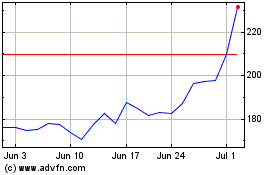NTSB Raises Doubts Fatal Tesla Crash Involved Autopilot -- Update
May 10 2021 - 5:51PM
Dow Jones News
By Rebecca Elliott
Federal safety officials have raised doubts that a fatal April
crash of a Tesla Inc. car involved the vehicle's advanced
driver-assistance system.
The National Transportation Safety Board issued a preliminary
report Monday that laid out some of the early evidence it has
gathered, while stopping short of drawing conclusions about what
caused the crash.
Tests at the crash site north of Houston using a representative
vehicle showed that one of the features that would have been needed
to use Tesla's driver-assistance system, known as Autopilot, wasn't
available in that area, the agency said.
Local officials in Texas had said that one of the two men riding
in the car was found in the front passenger's seat and the other in
the back seat. The local constable's office said, based on its
early investigation, that it was highly likely the vehicle didn't
have anyone in the driver's seat at the time of the crash, spurring
questions about how that may have unfolded. The early assessment
left questions about whether or how the vehicle could have been
operating without anyone in the driver's seat. Both men died in the
crash.
The NTSB said the vehicle owner's home-security system showed
the owner entering the driver's seat of the Model S sedan and the
other person entering the front passenger's seat. The NTSB report
didn't address when the owner eventually found dead in the back
seat moved within the vehicle.
The vehicle traveled about 550 feet before driving over a curb,
hitting a drainage culvert, a raised manhole and, eventually, a
tree, damaging the front of the vehicle's lithium-ion battery case,
the NTSB said.
The agency said that the resulting fire destroyed the vehicle
and damaged a module that can record data tied to information such
as vehicle speed, air-bag deployment and whether seat belts were
buckled. The NTSB said it had taken the device to a lab for further
analysis. Another onboard storage device that could yield clues
about what happened was destroyed by the fire, the NTSB said.
The initial report echoes statements from Tesla last month about
the crash. A Tesla executive said during an earnings call that the
company had conducted a study along with authorities in which it
tried to replicate the likely crash scenario. The company said that
a driver-assistance feature that helps with steering didn't engage
in the test, while another feature, adaptive cruise control, only
activated when a driver was buckled in and traveling at above 5
miles per hour.
The executive also said the car's steering wheel was found to be
deformed, "leading to the likelihood that someone was in the
driver's seat at the time of the crash." He didn't provide details
about how the company came to that conclusion. All the seat belts,
post crash, were found to be unbuckled, he said.
Tesla didn't immediately respond to a request for comment on the
NTSB's preliminary report. Soon after the crash, Tesla Chief
Executive Elon Musk tweeted, " Data logs recovered so far show
Autopilot was not enabled."
The NTSB said it was continuing to collect data on the crash,
including the dynamics of the incident and the postmortem
toxicology test results. "All aspects of the crash remain under
investigation," it said, adding it planned to issue a final report
with safety recommendations to prevent similar crashes.
The NTSB has said its probe also would examine the vehicle fire
that took hours to completely extinguish.
Write to Rebecca Elliott at rebecca.elliott@wsj.com
(END) Dow Jones Newswires
May 10, 2021 17:36 ET (21:36 GMT)
Copyright (c) 2021 Dow Jones & Company, Inc.
Tesla (NASDAQ:TSLA)
Historical Stock Chart
From Mar 2024 to Apr 2024

Tesla (NASDAQ:TSLA)
Historical Stock Chart
From Apr 2023 to Apr 2024
